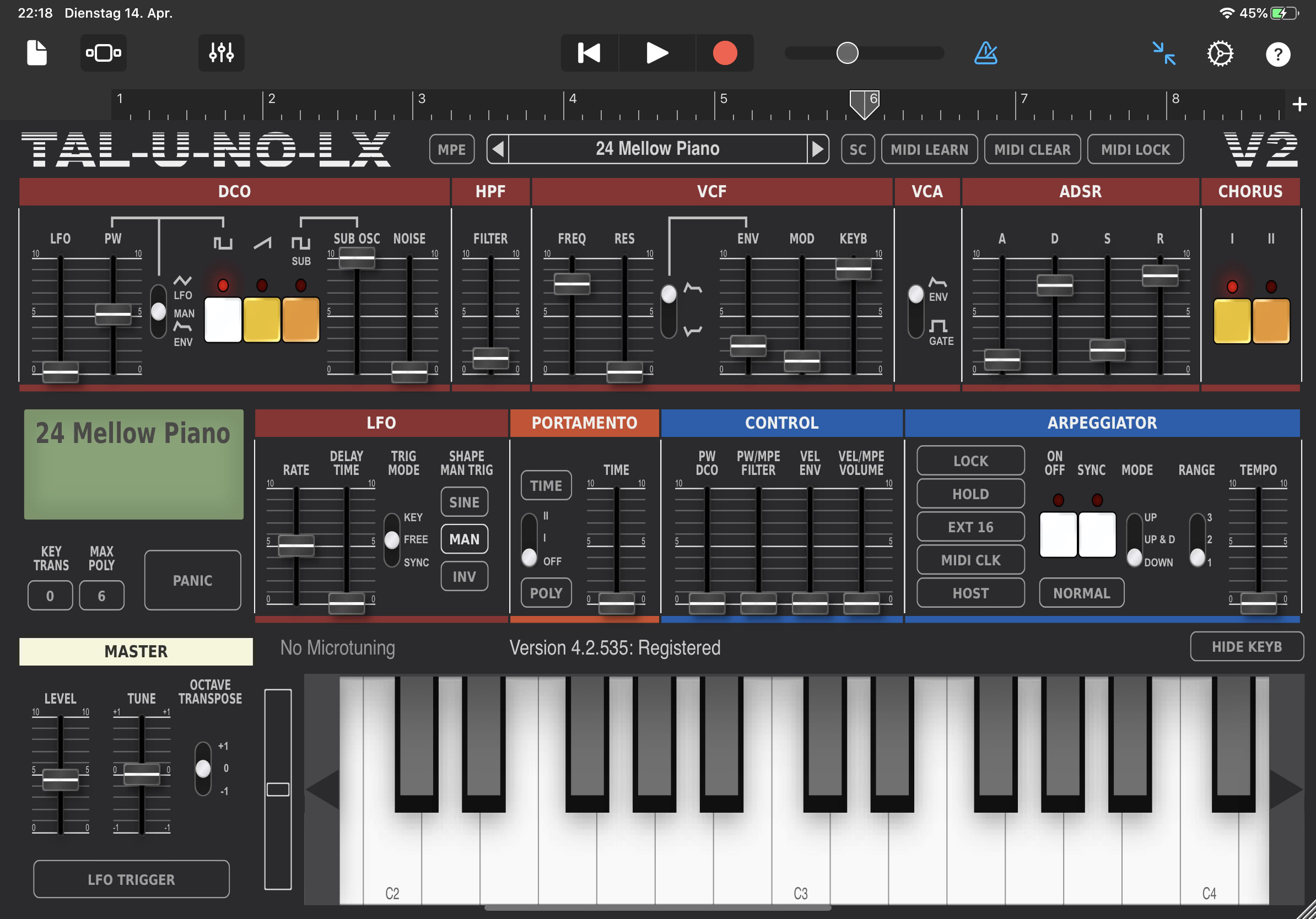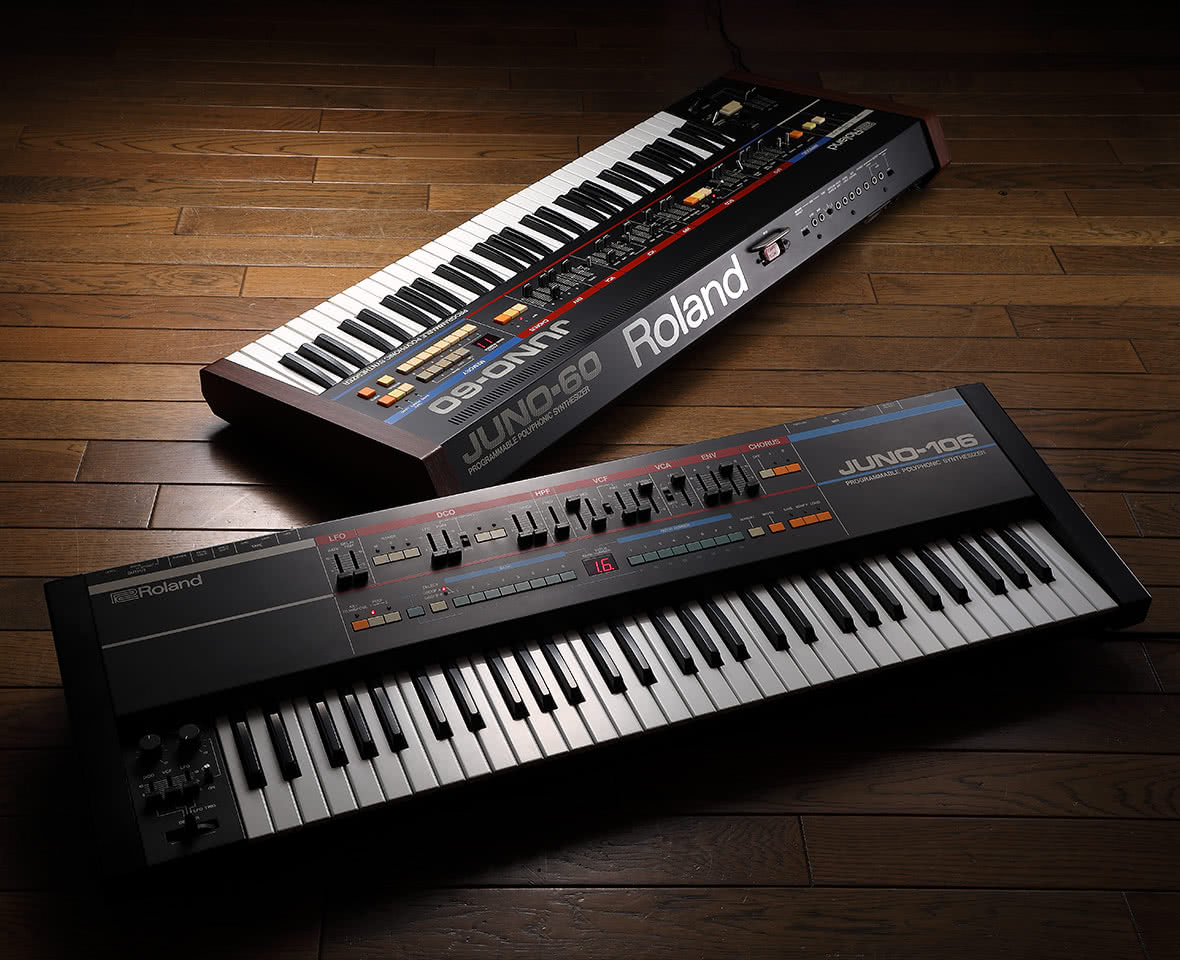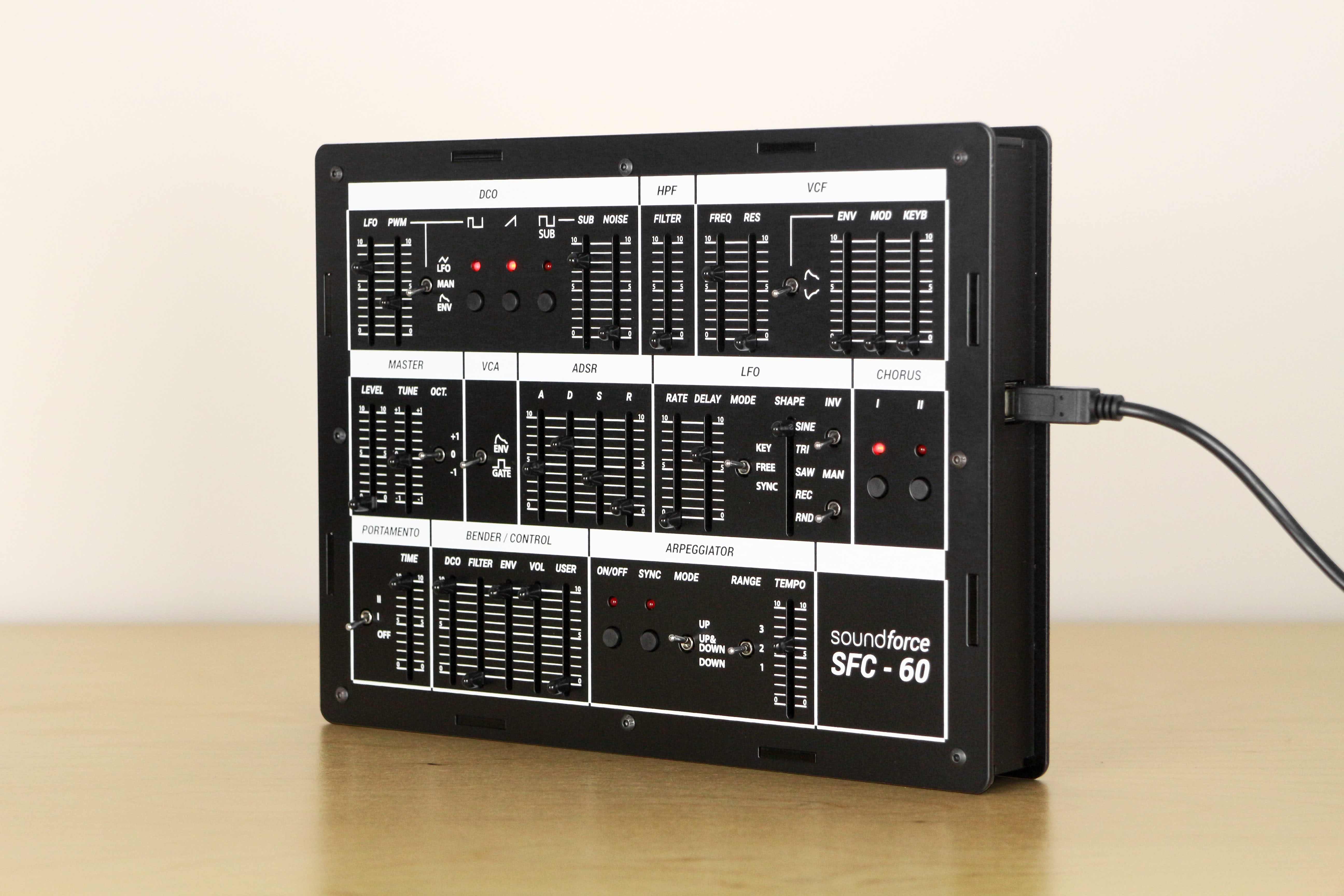 TAL-U-NO-LX on the iPad
TAL-U-NO-LX on the iPad
TAL Software recently released an iOS version of their highly regarded Juno 60 emulation. I spoke with TAL Software founder and developer Patrick Kunz, based in Lucerne, Switzerland, to find out a little more about how he has perfected this emulation over the years.
The Roland Juno Series
 The Roland Juno-6 and Juno-60
The Roland Juno-6 and Juno-60
The Roland Juno series was used on many classic 80s songs and continues to be popular today as a warm analog alternative to digital sounds. For instance, Animal Collective said most of the distinctive arpeggio sequences were created using a Juno and the built-in arpeggiator on the 2009 release of Merriweather Post Pavilion. Pet Shop Boys, The Cure, Madonna, Eurythmics, A Flock of Seagulls, A-ha, Mac Demarco, Alt-j, and Tame Impala are a few artists that have used a Roland Juno across several decades.
The Juno series began with the 6-voice polyphonic Juno-6 was released in 1982 and followed up by the Juno-60 a few months later. The Juno-60 featured patch memory for 56 sounds. The last in the series was the Juno-106 released in 1984 with more presets, and MIDI. See links at the end of this article for more history on the Juno.
Tal Software
See what Patrick has to say about Tal and the TAL-U-NO-LX iPad app.
TAL stands for Togu Audio Line. Does that name have a special meaning or a story?
Togu was a fun company name a friend and I used for our hobby music projects more than twenty years ago. I just added “Audio Line” when I started to make my first VST plug-ins back in the year 2000. Today most people just call us T.A.L.
What do you like most about the Juno-60?
I like the sound, the simplicity and it’s 80’s look.
The sound of the filter has it’s own character and is not clean and perfect like a Moog filter.
Can you talk about the lineage of the Juno 6, 60 and 106 lines?
I only owned a Juno 60 and a friend had a Juno 106. I especially like the filter sound. The sound of the filter has it’s own character and is not clean and perfect like a Moog filter. Also, the chorus is a great feature.
When was the first version of the desktop version of TAL-U-NO-LX released?
In the year 2012. It was our first commercial plug-in. The first free plug-in we released was MultiFilter around the year 2002.
TAL-U-NO-LX has been around a while, anything you can say about how your emulation has evolved over those years, why it is so great?
We made a lot of bug fixes and minor improvements. The sound did not change much. Our last addition was MPE support.
How did you perfect the emulation?
Having the filter was the first step. Most of the time I spent with listening tests, spectrum and waveform analysis and tuning. I compared it with our hardware Juno-60. Especially with extreme filter settings and self-oscillation.
What were the big changes with V2
The V2 changed the filter sound a little bit. We added more nonlinear elements to the filter. So I decided to make a V2 version back then. Today I wouldn’t make another version for such a minor sound change.
 TAL-U-NO-LX Oscilator Section
TAL-U-NO-LX Oscilator Section
What makes the TAL-Chorus-LX or the Juno-60 chorus so special?
I think the biggest advantage is, that the chorus has only two settings that just work.
What is the difference between mode I and mode II?
The modulation rate is different.
From Doug Woods review, it seems easy on the CPU. Was that hard to achieve?
There is always a quality to CPU usage compromise in DSP. Especially when using nonlinear components that introduce distortion. More powerful CPUs have helped us. Back in 2012, it was heavier on CPU usage, but today computers are much faster.
What were some of the challenges creating the AUv3 version?
One challenge was the iOS file system and sandboxing, but the main challenge, we are still working on, is the usability. It’s hard to port a mouse-controlled plug-in to the touch screen world.
How many voices does the iPad version of TAL-U-NO-LX support?
The iPad version has 12 Voices.
Are there any differences in functionality between the iPad and desktop versions?
There are some differences in how the preset handling works. Otherwise, we tried to support all desktop features.
 SFC-60 Controller V2
SFC-60 Controller V2
Did you work with SoundForce on the SFC-60 controller for TAL-U-NO-LX?
Yes, we have contact from time to time. We added a few features for this controller. I also own the latest version of the SFC-60.
Is there a manual for the iPad version of TAL-U-NO-LX?
No, there is only a manual for the desktop version because the plug-in is identical.
 TAL-U-NO-LX Controls Section
TAL-U-NO-LX Controls Section
Are there any interesting ways to program or perform with TAL-U-NO-LX that may not be obvious at first?
I like especially the self-oscillation. For this, you can disable all DCO’s put RES and KEYB to the max. Now you have a wonderful sine wave with slight distortion to play.
Do you have plans to bring any of your other emulations to the iPad?
We will see. It depends on how the feedback is for our first release on iOS.
Does the LX stand for 60 in roman numerals? Anything about the clever naming of TAL-U-NO-LX?
Yes, those are the roman numerals for 60. We just didn’t want to have trouble with Roland who created the original hardware. There was a case where a company had to rename their plugins because of this.
What language(s) do you use in your emulations?
It’s normal C++ and some Objective C for OS X.
Was your background in DSP before starting TAL?
I learned some basics when I studied software engineering and IT. After that I learned the most things by myself, reading books and with google.
How did you get started creating plugins and effects?
I just downloaded Steinberg’s vst2.4 SDK and started with a wave-shaper and volume plug-in. It just had to be noisy. This was my main goal back then. Other plug-ins sounded to clean in my ears compared to analog hardware.
Your desktop plug-ins work on all 3 platforms?
Yes, the desktop license is valid for all three platforms. Our first releases were windows only, but we received a lot of requests for OS X support. We added OS X and our latest addition is Linux and iOS. Cross-platform became very important for us since people tend to own different operating systems.
The most important thing is to stay in touch with the community and users and listen to them.
What aspects of this experience have been most rewarding?
You always learn new things. The most important thing is to stay in touch with the community and users and listen to them.
How can your customers help you?
Please report bugs, annoying things and crashes to our support. Only this way we can improve things.
Links
Tal Software
The first part of this video from Reverb.com demonstrates the beauty of the Juno sound
The Synth Sounds of Stranger Things | Reverb.com
Nice history of the Roland Juno series by Perfect Circuit
ROLAND JUNO-6 / JUNO-60 / JUNO-106
Dedicated hardware MIDI controller for TAL-U-NO-LX
Reverb Machine recreates a few Tame Impala songs using TAL-U-NO-LX
Roland’s own chronological list of their synths
Roland Synth Chronicle: 1973 – 2014
Roland interview with the developers of the Juno series
An Interview with the Legendary Developers of the JUPITER-8, JUNO-106, and JX-3P Synthesizers
Conclusion
My motivation for Synth Talk is to highlight the thought, effort, and philosophy that goes into designing a product.
There will be more articles to come highlighting the person and the process behind the products we love. Check back here or subscribe to the newsletter if you would like to hear more Synth Talk.
If you have suggestions or topics you want covered please contact me. 🙂

